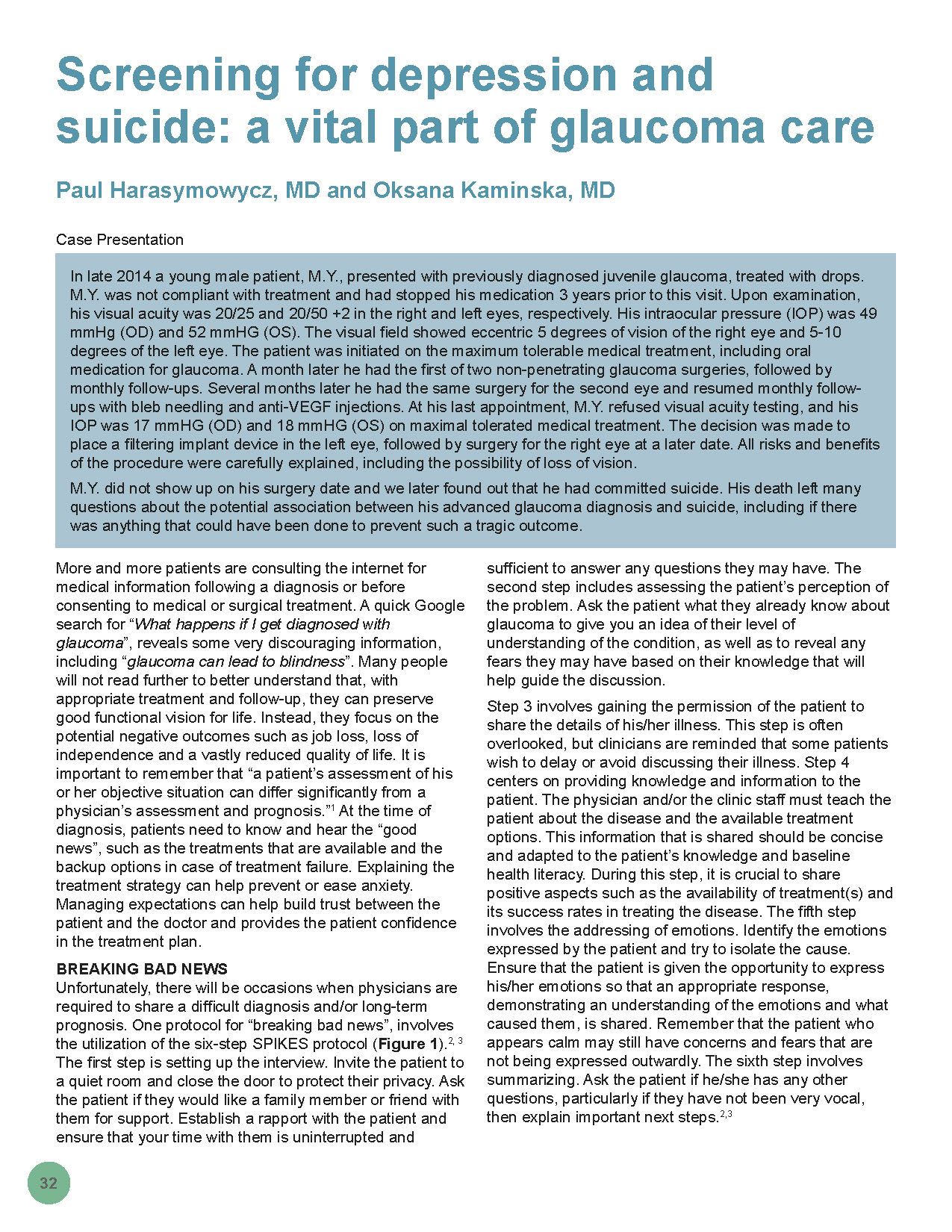Screening for depression and suicide: a vital part of glaucoma care
DOI:
https://doi.org/10.58931/cect.2022.1215Abstract
More and more patients are consulting the internet for medical information following a diagnosis or before consenting to medical or surgical treatment. A quick Google search for “What happens if I get diagnosed with glaucoma”, reveals some very discouraging information, including “glaucoma can lead to blindness”. Many people will not read further to better understand that, with appropriate treatment and follow-up, they can preserve good functional vision for life. Instead, they focus on the potential negative outcomes such as job loss, loss of independence and a vastly reduced quality of life. It is important to remember that “a patient’s assessment of his or her objective situation can differ significantly from a physician’s assessment and prognosis.” At the time of diagnosis, patients need to know and hear the “good news”, such as the treatments that are available and the backup options in case of treatment failure. Explaining the treatment strategy can help prevent or ease anxiety. Managing expectations can help build trust between the patient and the doctor and provides the patient confidence in the treatment plan.
References
Shahid KS. Recognizing the patient at risk for depression after vision loss. Cataract & Refractive Surgery Today Global. 2016 Mar [accessed 2022]. https://crstodayeurope.com/articles/2016-mar/recognizing-the-patient-at-risk-for-depression-after-vision-loss.
Buckman RA. “Breaking bad news: the S-P-I-K-E-S strategy.” Community Oncology. 2005 Mar;2:138-142. DOI: https://doi.org/10.1016/S1548-5315(11)70867-1
Singh MM. Breaking bad news in clinical setting: a systematic review. Indian Journal of Applied Research. 2017;7(12):29-32.
Chen YY, Lai YJ, Wang JP, Shen YC, Wang CY, et al. The association between glaucoma and risk of depression: a nationwide population-based cohort study. BMC Ophthalmol. 2018 Jun 22;18(1):146. doi:10.1186/s12886-018-0811-5 DOI: https://doi.org/10.1186/s12886-018-0811-5
Musch DC, Niziol LM, Janz NK, Gillespie BW. Trends in and Predictors of Depression among Participants in the Collaborative Initial Glaucoma Treatment Study (CIGTS). Am J Ophthalmol. 2019 Jan;197:128-135. doi:10.1016/j.ajo.2018.09.015 DOI: https://doi.org/10.1016/j.ajo.2018.09.015
Zheng Y, Wu X, Lin X, Lin H. The Prevalence of Depression and Depressive Symptoms among Eye Disease Patients: A Systematic Review and Meta-analysis.” Sci Rep. 2017 Apr 12;7:46453. doi:10.1038/srep46453 DOI: https://doi.org/10.1038/srep46453
Holloway EE, Sturrock BA, Lamoureux EL, Keefe JE, Rees G. Depression screening among older adults attending low-vision rehabilitation and eye-care services: Characteristics of those who screen positive and client acceptability of screening. Australas J Ageing. 2015 Dec;34(4):229-34. doi:10.1111/ajag.12159 DOI: https://doi.org/10.1111/ajag.12159
Kroenke K, Spitzer RL, Williams JBW. The Patient Health Questionnaire-2: validity of a two-item depression screener. Med Care. 2003 Nov;41(11):1284-92. doi:10.1097/01.MLR.0000093487.78664.3C DOI: https://doi.org/10.1097/01.MLR.0000093487.78664.3C
Bertolote JM, Fleischmann A, De Leo D, Wasserman D. Psychiatric diagnoses and suicide: revisiting the evidence. Crisis. 2004;25(4):147-55. doi:10.1027/0227-5910.25.4.147 DOI: https://doi.org/10.1027/0227-5910.25.4.147
Adults ASQ Toolkit. NIMH Information Resource Center. [accessed 2022 May]. https://www.nimh.nih.gov/research/research-conducted-at-nimh/asq-toolkit-materials/adults-asq-toolkit.
Suicide in Canada: Key statistics. Public Health Agency of Canada. 2020 Mar 4 [accessed 2022 May]. https://www.canada.ca/en/public-health/services/publications/healthy-living/suicide-canada-key-statistics-infographic.html.
Schreiber J, Culpepper L. Suicidal ideation and behavior in adults. UpToDate. 2022 [accessed 2022 May]. Figure: Algorithm for medically stable adults with suicidal ideation. https://www.uptodate.com/contents/suicidal-ideation-and-behavior-in-adults.
Gliatto MF, Rai AK. Evaluation and treatment of patients with suicidal ideation.Am Fam Physician. 1999 Mar 15;59(6):1500-6.
Simon RI. Suicide risk assessment in managed care settings. Primary Psychiatry. 2002;9:42-49.

Published
How to Cite
Issue
Section
License
Copyright (c) 2022 Canadian Eye Care Today

This work is licensed under a Creative Commons Attribution-NonCommercial-NoDerivatives 4.0 International License.
